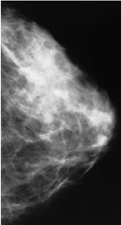Understanding Mammograms
Download this fact sheet in PDF format (202KB).
What is a mammogram?
A mammogram is an x-ray picture of the breast. Doctors use a mammogram to look for early signs of breast cancer.
Why should I get a mammogram?
Regular mammograms are the best tests doctors have to find breast cancer early, sometimes up to three years before it can be felt. When their breast cancer is found early, many women go on to live long and healthy lives.
When should I get a mammogram?
Most women should have their first mammogram at age 40 and then have another mammogram every one or two years. Talk to your health professional if you have any symptoms or changes in your breast, or if breast cancer runs in your family. He or she may recommend that you have mammograms before age 40 or more often than usual.
How is a mammogram done?
You will stand in front of a special x-ray machine. A technologist will place your breast on a clear plastic plate. Another plate will firmly press your breast from above. The plates will flatten the breast, holding it still while the x-ray is being taken. You will feel some pressure. The other breast will be x-rayed in the same way. The steps are then repeated to make a side view of each breast. You will then wait while the technologist checks the four x-rays to make sure the pictures do not need to be re-done. Keep in mind that the technologist cannot tell you the results of your mammogram.
What does having a mammogram feel like?
Having a mammogram is uncomfortable for most women. Some women find it painful. A mammogram takes only a few moments, though, and the discomfort is over soon. What you feel depends on the skill of the technologist, the size of your breasts, and how much they need to be pressed. Your breasts may be more sensitive if you are about to get or have your period.
Before you get a mammogram, you may want to ask the following questions:
- What will happen? How long will I be there?
- Do you have my previous mammograms?
- When will my doctor get the results?
- When and how will I learn about the results?
- When will I need to have my next mammogram?

What does a mammogram look like?
An example of a normal mammogram is shown here. Each woman's mammogram may look a little different because all breasts are a little different. A doctor with special training, called a radiologist, will read the mammogram. He or she will look at the x-ray for early signs of breast cancer or other problems.
When will I get the results of my mammogram?
You will usually get the results within a few weeks, although it depends on the facility. A radiologist reads your mammogram and then reports the results to you or your doctor. If there is a concern, you will hear from the mammography facility earlier. Contact your health professional or the mammography facility if you do not receive a report of your results within 30 days.
Tips for getting a mammogram
- Try not to have your mammogram the week before you get your period or during your period. Your breasts may be tender or swollen then.
- On the day of your mammogram, don't wear deodorant, perfume, or powder. These products can show up as white spots on the x-ray.
- Some women prefer to wear a top with a skirt or pants, instead of a dress. You will need to undress from your waist up for the mammogram.
What happens if my mammogram is normal?
Continue to get regular mammograms. Mammograms work best when they can be compared with previous ones. This allows your doctor to compare them to look for changes in your breasts.
What happens if my mammogram is abnormal?
If it is abnormal, do not panic. An abnormal mammogram does not always mean that there is cancer. But you will need to have additional mammograms, tests, or exams before the doctor can tell for sure. You may also be referred to a breast specialist or a surgeon. It does not necessarily mean you have cancer or need surgery. These doctors are experts in diagnosing breast problems.
Where can I get a mammogram and who can I talk to if I have questions?
 Please note: Some of these publications are available for download only as *.pdf files. These files require Adobe Acrobat Reader in order to be viewed. Please review the information on downloading and using Acrobat Reader software. Please note: Some of these publications are available for download only as *.pdf files. These files require Adobe Acrobat Reader in order to be viewed. Please review the information on downloading and using Acrobat Reader software.
|
